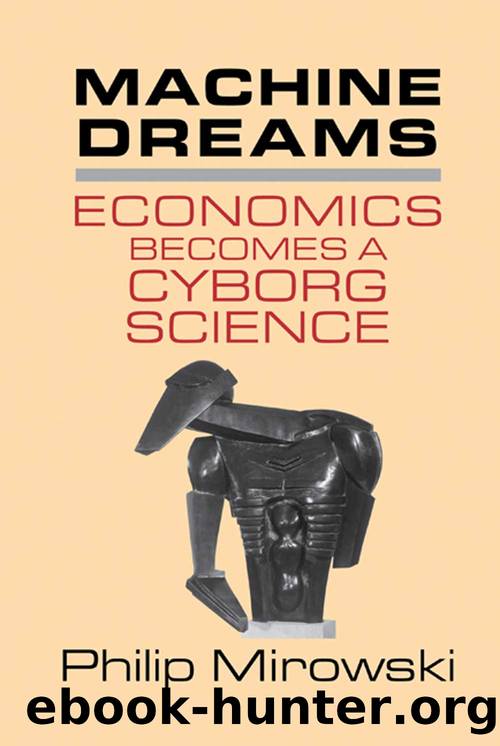Machine Dreams by Philip Mirowski

Author:Philip Mirowski [Mirowski, Philip]
Language: eng
Format: epub
Publisher: Cambridge University Press
Published: 2001-12-03T00:00:00+00:00
Suppose Alchian and Williams both chose “cooperation”; then Alchian would receive half a cent, while Williams would win a cent (Flood had them playing for pennies). The point of the payoff matrix was that if either player examined this cooperation point, they would realize that they personally could do better by shifting to noncooperation or “defection”; the Nash solution concept insisted both would necessarily comprehend this about the other, and therefore the Nash equilibrium would be for both to defect. Alchian would have to settle for zilch, and Williams for half a cent, if Nash had fully captured the notion of strategic rationality. Flood, characteristically, was not happy with this construction of rationality, and decided to plumb the social aspects of coordination and defection through repeated play of the game, having both Alchian and Williams record their motivations and reactions in each round (reported in Flood, 1958a, pp. 24–26, and in Poundstone, 1992, pp. 108–16).
Although both RAND researchers were familiar with von Neumann’s game theory, Flood reports that they were not aware of the Nash solution concept at that juncture. Both players, aware of each other’s identities, were enjoined not to make any efforts at direct communication or side payments. The prescribed Nash equilibrium turned out not to be the preferred or dominant modality of play, with Alchian choosing cooperation 68 times out of 100, and Williams choosing cooperation 78 times. In their recorded comments, Williams began by expecting both to cooperate to maximize their earnings, whereas Alchian expected defection (recall Alchian was the neoclassical economist, Williams the mathematician). Williams also believed that, because the payoffs were skewed in his favor, he had effective control of the game, and although both had equivalent access to the same payoff matrix, his play was devoted to getting Alchian to learn that fact. Their comments were studded with non-Nashian reflections such as: “I’m completely confused. Is he trying to convey information to me?” and “This is like toilet-training a child – you have to be very patient.” Flood concluded, “there was no tendency to seek as the final solution either the Nash equilibrium point or the [split the difference] point x = y = 0.6 which was available to them” (1958a, p. 16).
Nash, who was immediately apprized of these results, of course did not agree with their interpretation. His response was a litany of the Duhemstyle auxiliary hypotheses, which were more revealing of his own approach to game theory than of any behaviorist concern with gauging the extent of the psychological accuracy of the exercise:
The flaw in this experiment as a test of equilibrium point theory is that the experiment really amounts to having the players play one large multimove game. On cannot just as well think of the thing as a sequence of independent games as one can in the zero-sum cases. There is too much interaction .... Viewing it as a multimove game a strategy is a complete program of action, including reactions to what the other player has done. . .
Download
This site does not store any files on its server. We only index and link to content provided by other sites. Please contact the content providers to delete copyright contents if any and email us, we'll remove relevant links or contents immediately.
Pale Blue Dot by Carl Sagan(4867)
The Rules Do Not Apply by Ariel Levy(4797)
Goodbye Paradise(3672)
Ogilvy on Advertising by David Ogilvy(3464)
Delivering Happiness by Tony Hsieh(3339)
Liar's Poker by Michael Lewis(3330)
Into Thin Air by Jon Krakauer(3269)
Purple Cow by Seth Godin(3112)
Rogue Trader by Leeson Nick(2950)
The Social Psychology of Inequality by Unknown(2908)
The Airbnb Story by Leigh Gallagher(2757)
4 - Harry Potter and the Goblet of Fire by J.K. Rowling(2621)
The Mind Map Book by Tony Buzan(2481)
Bossypants by Tina Fey(2432)
Claridge's: The Cookbook by Nail Martyn & Erickson Meredith(2323)
All the President's Men by Carl Bernstein & Bob Woodward(2305)
Six Billion Shoppers by Porter Erisman(2246)
Master of the Game by Sidney Sheldon(2211)
Alibaba by Duncan Clark(2007)
